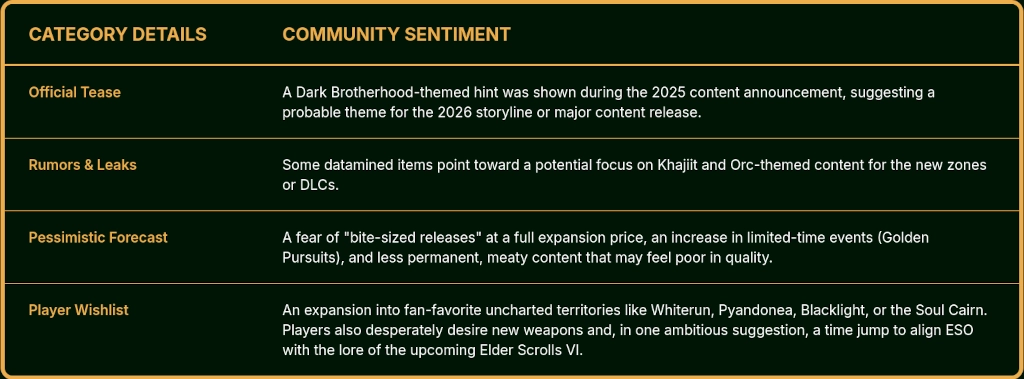
The State of Tamriel: Is ESO Dying or Just Evolving? What the Community Expects from 2026
I recently put the question to the ESO community: “What can we expect from The Elder Scrolls Online in 2026, and is the game dying or just adjusting to the recent management changes?“
After consolidating responses from long-time players across various forums, a clear picture emerges. The community is deeply divided, passionately critical, yet holds out hope for a handful of crucial technical and quality-of-life updates. Here is a consolidated look at what players are forecasting for the next year and beyond.
1. The Core Conflict: Bleak Times vs. The 30-Year ESO Plan
The central disagreement lies in the game’s overall health.
The Pessimistic View:
Many veterans who have played for a decade describe the current period as “one of the bleakest times” they’ve ever seen. This group points to a palpable decline in endgame activity (fading veteran trial groups), the atrocious management sentiment, and the game seemingly entering a “maintenance mode.” The shift from yearly Chapters to smaller, seasonal content releases is viewed by critics as ZOS running out of map space and capacity for large-scale content.
The Optimistic View:
Other players dismiss the “dying game” narrative as forum and “clickbait” negativity. They highlight a massive overall player base (even if Cyrodiil isn’t always full), the recent implementation of console add-ons, and ZOS’s own promise of a 30-year future for the game. For this group, the game is simply at a “slow point.
The consensus?
The game won’t die, but 2026 is widely considered a “wait-and-see” year. The concern is that ZOS might be “reaping what they can without investing a penny,” prioritizing the Crown Store’s smooth functionality over fixing core game issues.
2. The Technical Lifelines: ESO Crossplay and New-Gen Focus
If there is one technical change that the community sees as both necessary and likely to “save the numbers,” it is crossplay.
Full Crossplay:
This is the most demanded technical feature. Console players, in particular (PS and Xbox EU), often describe their servers as “dead af” and believe that full cross-play between PC, Xbox, and PlayStation is the only way to boost population, fix long queue times, and make end-game PvE and PvP playable again. Some players are hopeful, citing ZOS is already working on it.
Ditching Old Hardware:
A strong contingent of players hopes that ZOS will finally drop support for PS4 and Xbox One. The theory is that clinging to old-gen consoles prevents modern, ambitious updates and chains the development team to restrictive hardware limitations.
3. What to Expect from ESO in 2026
While ZOS is playing its cards close to the chest, players are working off a mix of official hints and hopeful speculation.

4. ESO’s Path Forward: Fixing Broken Systems
Beyond new zones, the biggest source of current player frustration stems from fundamental systems that need immediate attention.
The Subclassing Disaster:
Subclassing (multiclassing) had “promise,” but its poor implementation and subsequent lack of balance have alienated a “massive amount of players.” Critics feel ZOS “just poured every spice possible in and walked away,” resulting in wildly unbalanced PvE and unkillable PvP builds. The community is desperate for thoughtful adjustments to make pure-classing viable again.
Meaningful Progression:
After Champion Point 1800, progression “basically stops meaning anything.” Players demand more reasons to grind, with suggestions ranging from new achievements, mounts, or cosmetics to a veteran overland difficulty update.
The Crown Store Priority:
There is a widespread, almost cynical joke that players can always expect the Crown Store to remain functional at all times, even if the rest of the game is broken. This perception fuels the belief that the current management direction prioritizes monetization above all else.
The overall sentiment is that ZOS has a loyal ESO player base that desperately cares about the game, but that loyalty is being tested. The hope for 2026 is that the new management structure will listen to community feedback (particularly on balance and technical debt) and finally deliver the quality, innovative content that has felt missing in recent years.